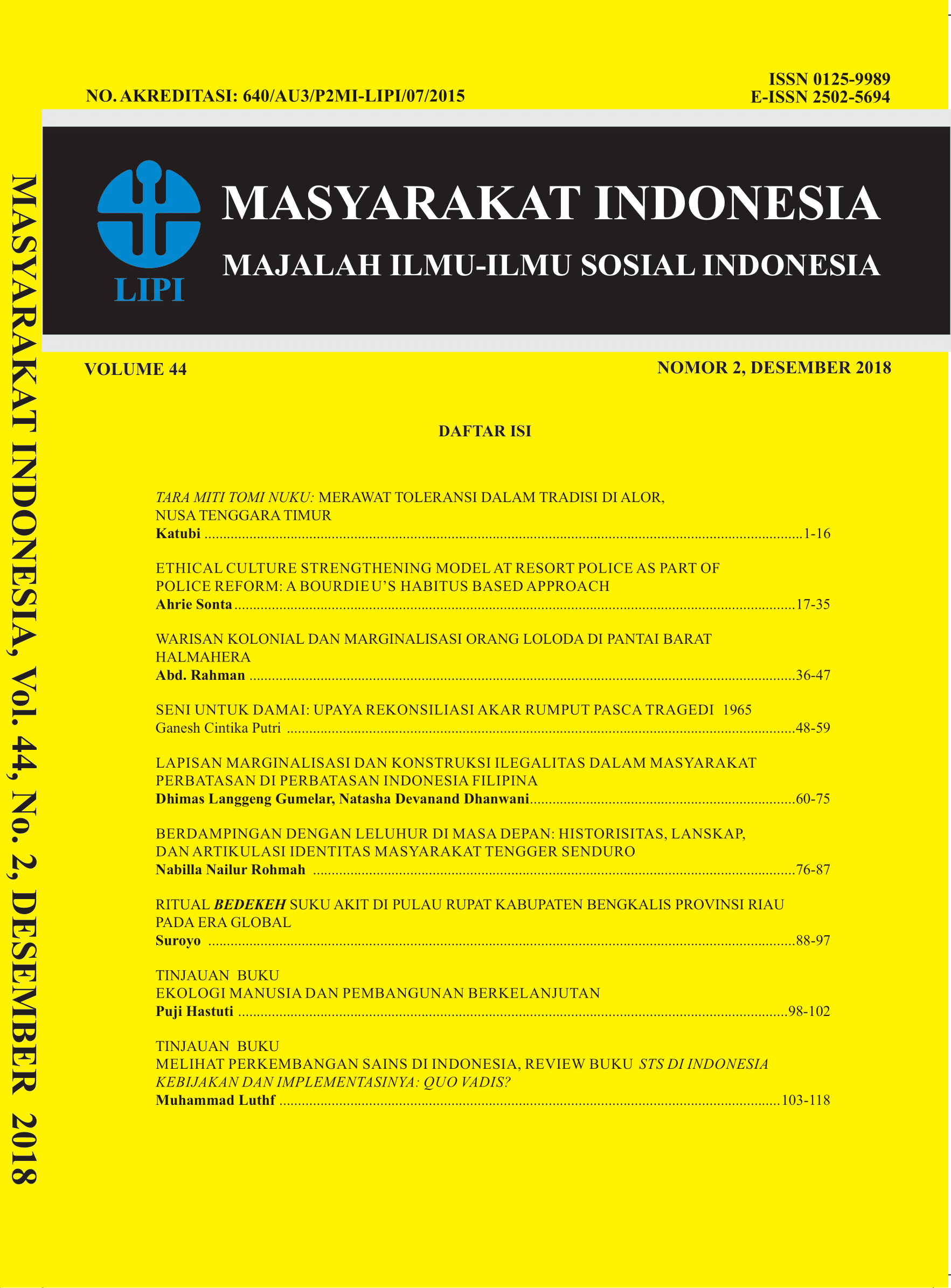Berdampingan dengan Leluhur di Masa Depan: Historisitas, Lanskap, dan Artikulasi Identitas Masyarakat Tengger Senduro
DOI:
https://doi.org/10.14203/jmi.v44i2.857Keywords:
Tengger Senduro, Puncak B29, Puncak Songolikur, Historicity, ArticulationAbstract
Abstract
This article studies the historical significances of the ancestral tenet and the landscape of Puncak Songolikur for Tengger people in Senduro and how they are being performed, represented, and reconstructed in the present historical context. In this paper, the Folklore of Tengger about “Joko Seger and Roro Anteng†is studied neither as legend nor myth, but as public history which has relevances to the present social realities. For them, the story of the origin of their ancestor encompasses the overall theological framework that underlies the social order and cultural practices in their everyday life. The five religions policy during authoritarian New Order regime has led to a massive Hinduization and Islamization which has great influence on social and cultural order of Tengger people. Moreover, the enforcement of national park and tourism policy in their living space has raised greater challenge which manifests an increasingly capitalistic and profane life order. Under this condition, Puncak Songolikur presents and preserves the historical narrative about their ancestor as well as spiritual values, social order, cultural practice, and all the way of life. However, the development of tourist destination “Puncak B29†in the landscape of Puncak Songolikur since 2013 has become both challenge and opportunity for their historical narratives. This paper explores how tourism developent maintains and simultaneously contests the historicity of Puncak Songolikur. It includes how people assert, negotiate, and rearticulate their identity in nowadays cosmopolite historical horizon.
References
Andrianto, A. (2013) Eksistensi Dukun dan Kontrol Sosial Pada Masyarakat Tengger. Dalam Sumintarsih dkk., Kearifan Lokal, 281-340. Balai Pelestarian Nilai Budaya (BPNB) Daerah Istimewa Yogyakarta.
Assmann, A. (2008) Canon and Archive. Dalam Erl dan NÏ‹nning (Eds.), Cultural Memory Studies: An International and Interdisciplinary Handbook, 97-107.
Assmann, J. (2008) Communicative and Cultural Memory. Dalam Erl dan NÏ‹nning (Eds.). Cultural Memory Studies: An International and Interdisciplinary Handbook, 109-118.
Barker, C. (2002). Making sense of cultural studies: Central problems and critical debates. Sage.
Batoro, J. (2017). Keajaiban Bromo Tengger Semeru. Universitas Brawijaya Press.
Bastian, J. A. (2014). Records, memory and space: Locating archives in the landscape. Public History Review, 21, 45.
Grossberg, L. (2005). On Postmodernism and Articulation: An Interview With Stuart Hall. Dalam David Morley dan Kuan Hsing Chen (Eds). Stuart Hall: Critical Dialogue in Cultural Studies (pp. 113-129). Routledge.
Hefner, R. W. (1999). Geger Tengger. Yogyakarta: LKiS.
Hefner, R. W. (1990). Hindu Javanese: Tengger Tradition and Islam. Princeton University Press.
Ireland, T., & Lydon, J. (2016). Rethinking Materiality, Memory and Identity. Public History Review, 23, 1-8.
Hadi, N., Urbiyanto, U., & Purwendarti, S. (2010). Penetrasi agama negara dan pengaruhnya terhadap ritual tradisional pada komunitas Tengger di kantong taman nasional Bromo-Tengger-Semeru: laporan penelitian fundamental tahun ke-2: sosial. Universitas Negeri Malang.
Haryanto, J.T. 2016. Pesan Kerukunan Cerita Lisan Masyarakat Tengger Desa Ngadas Kabupaten Malang. Jurnal Studi Masyarakat, Religi, dan Tradisi. 02 (02) Halaman 131-142
Kalela, J. (2013). History Making: The Historian as Consultant. Public History Review, 20, 24-41.
Nandy, A. (2015). Memory work. Inter-Asia Cultural Studies, 16(4), 598-606.
Rodman, G. B. (2013). Cultural studies and history. The Sage Companion to Historical Theory, 342-353
Setiawan, I., Tallapessy, A., Subaharianto, A. (2015). “Politik Identitas Etnis Pasca Reformasi: Studi Kasus Pada Komunitas Tengger Dan Usingâ€. Laporan Penelitian. Fakultas Sastra Universitas Jember.
Slack, J. D. (2005). The theory and method of articulation in cultural studies. Dalam David Morley dan Kuan Hsing Chen (Eds). Stuart Hall: Critical Dialogue in Cultural Studies (pp. 113-129). Routledge
Sutarto, A. (2006). Sekilas tentang masyarakat Tengger. Makalah disampaikan pada acara pembekalan Jelajah Budaya, 7-10. (online), (http://kebudayaan.kemdikbud.go.id/bpnbyogyakarta/wpcontent/uploads/sites/24/2014/06/Masyarakat_Tengger.pdf) diakses pada 15 Mei 2018 Pukul 00.05.
Sutarto. (1997). Legenda kasada dan karo orang Tengger, Lumajang. Fakultas Sastra Universitas Indonesia.
Waluyo, H. (1997). Sistem pemerintahan tradisional di Tengger Jawa Timur. Departemen Pendidikan dan Kebudayaan, Direktorat Jenderal Kebudayaan, Direktorat Sejarah dan Nilai Tradisional, Proyek Pengkajian dan Pembinaan Nilai-Nilai Budaya.
Warouw, N., Adrianto, A., Harnoko, D., Ambarwati, A., Priyanggono, A., Pradnyaswari, N. P. A. A., & Agustini, B. L. (2012). Inventarisasi dan komunitas adat Tengger, Ngadisari, Sukapura, Probolinggo, Jawa Timur. Balai Pelestarian Nilai Budaya Daerah Istimewa Yogyakarta bekerja sama dengan Fakultas Ilmu Budaya, Universitas Gadjah Mada.
Woodward, I. (2007). Understanding material culture. Sage.
Rujukan Media Online
“Asal Mula Tengger†Situs Resmi Pemeintah Kabupaten Pasuruan (10 Mei 2017) diakses pada 9 Mei 2018 Pukul 22.34 WIB dari http://pasuruankab.go.id/cerita-36-asal-mula-tengger.html.
Taufiqurrohman (2016). Jelajah Taman Mbah Bromo, diakses pada 10 Mei 2018 Pukul 00.23 WIB dari http://arsip.gatra.com/2016-03-28/majalah/artikel.php
“Jabal Nur Masjid Eksotis di Lereng Semeruâ€. Hidayatullah.com (6 Mei 2010) diakses pada 15 Mei 2018 Pukul 00.40 dari https://www.hidayatullah.com/feature/read/ 2010/05/06/43355/jabal-nur-masjid-eksotis-di-lereng-semeru.html
“Legenda di Balik Indahnya Puncak B29 Lumajangâ€. Kompas.com (14 Mei 2017) diakses pada 9 Mei 2018 Pukul 23.40 darihttps://travel.kompas.com/ read/2017 /05/14/16080 0727/legenda.di.balik.indahnya.puncak.b29.lumajang
Downloads
Published
How to Cite
Issue
Section
License
Copyright (c) 2020 Author(s)

This work is licensed under a Creative Commons Attribution-ShareAlike 4.0 International License.


